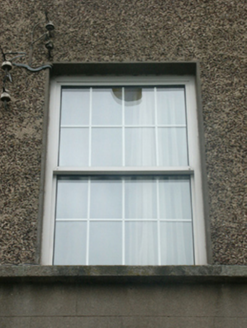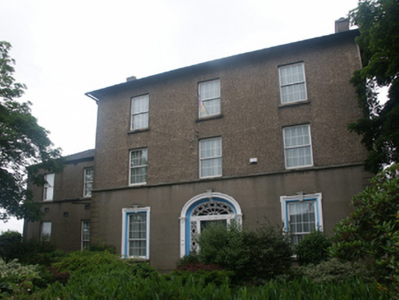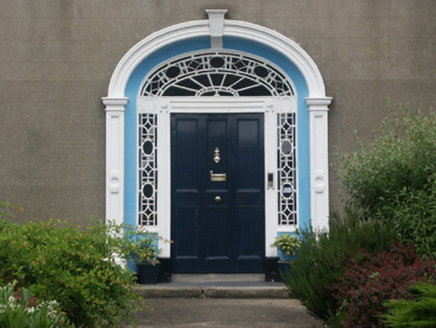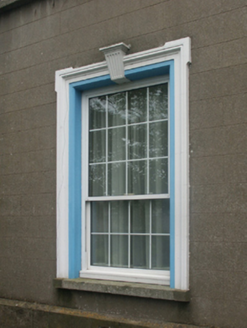Survey Data
Reg No
15502162
Rating
Regional
Categories of Special Interest
Architectural, Artistic, Historical, Social
Previous Name
The Manse
Original Use
Presbytery/parochial/curate's house
In Use As
Presbytery/parochial/curate's house
Date
1835 - 1840
Coordinates
304773, 121622
Date Recorded
07/07/2005
Date Updated
--/--/--
Description
Detached three-bay three-storey presbytery, built 1838, on a T-shaped plan with single-bay (two-bay deep) three-storey central return (west). Extended, 1899, producing present composition. Occupied, 1901; 1911. Refenestrated, 1994. Hipped slate roof on a T-shaped plan centred on hipped slate roof (west) with clay ridge tiles, rendered chimney stacks having cut-granite capping supporting terracotta pots, and cast-iron rainwater goods on slightly overhanging slate flagged eaves retaining cast-iron downpipes. Rendered, ruled and lined walls (ground floor) on rendered chamfered plinth with rusticated rendered piers to corners; gritdashed roughcast surface finish (upper floors) with rendered flush strips to corners. Elliptical- or segmental-headed central door opening with limestone flagged cut-granite step supporting cast-iron bootscrapers, timber doorcase with flush beaded pilasters on cut-granite padstones supporting flush beaded transom, and rendered surround with roundel-detailed panelled pilasters supporting archivolt centred on fluted keystone framing timber panelled concave door having sidelights below fanlight. Square-headed window openings (ground floor) with cut-granite sills, and moulded rendered lugged surrounds centred on fluted keystones framing twelve-over-eight uPVC sash windows replacing eight-over-eight timber sash windows having overlights. Square-headed window openings (upper floors) with cut-granite sill course (first floor) or cut-granite sills (top floor), and concealed dressings framing replacement eight-over-eight uPVC sash windows replacing eight-over-eight timber sash windows. Interior including (ground floor): central hall retaining carved timber surrounds to door openings framing timber panelled doors, and plasterwork cornice to ceiling; segmental-headed door opening into staircase hall with sidelights on panelled risers below fanlight; staircase hall retaining carved timber surrounds to door openings framing timber panelled doors, cantilevered staircase on a dog leg plan with timber balusters supporting carved timber banister, and carved timber surrounds to door openings to landings framing timber panelled doors; and carved timber surrounds to door openings to remainder framing timber panelled doors with carved timber surrounds to window openings framing panelled shutters on panelled risers. Set back from line of street in landscaped grounds.
Appraisal
A presbytery representing an important component of the built heritage of Wexford with the architectural value of the composition, one erected on 'a piece of ground obtained [1833] by Reverend George Murphy for the building of a residence for the clergy' (English 1958, 109), confirmed by such attributes as the compact plan form centred on a Classically-detailed concave doorcase not only demonstrating good quality workmanship, but also showing a pretty fanlight; and the diminishing in scale of the openings on each floor producing a graduated visual impression with the principal "apartments" or reception rooms originally showing so-called "Wexford Window" sash-and-overlight glazing patterns. Having been well maintained, the elementary form and massing survive intact together with substantial quantities of the original fabric, both to the exterior and to the interior where contemporary joinery; chimneypieces; and plasterwork refinements, all highlight the artistic potential of a presbytery making a pleasing visual statement in School Street. NOTE: Occupied by a succession of Parish Administrators including Reverend Michael Kelly (d. 1889), 'Roman Catholic Clergyman late of The Manse Wexford County Wexford' (Calendars of Wills and Administrations 1889, 362); Reverend Patrick Doyle (----), 'Roman Catholic Administrator' (NA 1901); and Reverend Thomas Cloney (----), 'Administrator of Parish' (NA 1911).







